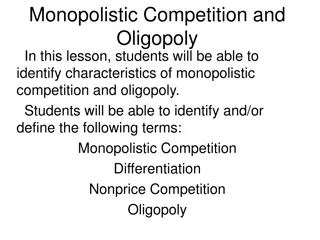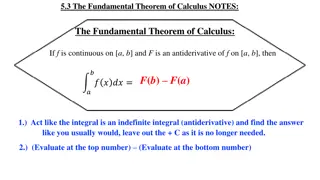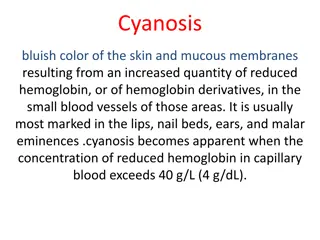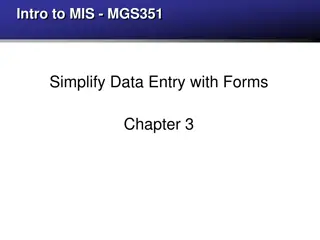
Understanding Differentiation: Concepts and Applications
Explore the realm of differentiation in mathematics, covering topics such as finding gradients, determining max/min points, curve sketching, and optimizing functions. Understand how gradients change on curves and the process of differentiation to find the rate of change.
Download Presentation

Please find below an Image/Link to download the presentation.
The content on the website is provided AS IS for your information and personal use only. It may not be sold, licensed, or shared on other websites without obtaining consent from the author. If you encounter any issues during the download, it is possible that the publisher has removed the file from their server.
You are allowed to download the files provided on this website for personal or commercial use, subject to the condition that they are used lawfully. All files are the property of their respective owners.
The content on the website is provided AS IS for your information and personal use only. It may not be sold, licensed, or shared on other websites without obtaining consent from the author.
E N D
Presentation Transcript
DIFFERENTIATION Learning Outcomes Using differentiation (Application) Finding the gradient for a polynomial Increasing / Decreasing functions Max / Min and inflexion Points Differentiating Brackets ( Type 1 ) Curve Sketching Differentiating Harder Terms (Type 2) Max & Min Values on closed Intervals Equation of a Tangent Line ( Type 3 ) Optimization
Gradients & Curves On a straight line the gradient remains constant, however with curves the gradient changes continually, and the gradient at any point is in fact the same as the gradient of the tangent at that point. The sides of the half-pipe are very steep(S) but it is not very steep near the base(B). S Demo B
Gradients & Curves Gradient of tangent = gradient of curve at A A B Gradient of tangent = gradient of curve at B
To find the gradient at any point on a curve we need to modify the gradient formula Gradients & Curves Outcome 3 y x - - y x m 2 1 = 2 1 Higher For the function y = f(x) we do this by taking the point (x, f(x)) and another very close point ((x+h), f(x+h)). Then we find the gradient between the two. ((x+h), f(x+h)) Approx gradient (x, f(x)) True gradient
Gradients & Curves The gradient is not exactly the same but is quite close to the actual value We can improve the approximation by making the value of h smaller This means the two points are closer together. ((x+h), f(x+h)) Approx gradient (x, f(x)) True gradient
Gradients & Curves We can improve upon this approximation by making the value of h even smaller. So the points are even closer together. ((x+h), f(x+h)) True gradient Approx gradient (x, f(x))
Derivative We have seen that on curves the gradient changes continually and is dependant on the position on the curve. ie the x-value of the given point. Differentiating Finding the GRADIENT The process of finding the gradient is called Finding the rate of change DIFFERENTIATING or FINDING THE DERIVATIVE (Gradient)
Derivative If the formula/equation of the curve is given by f(x) Then the derivative is called f '(x) - f dash x There is a simple way of finding f '(x) from f(x). f(x) f '(x) 2x2 4x2 5x10 6x7 42x6 x3 3x2 x5 5x4 x99 99x98 4x 8x 50x9 Have guessed the rule yet !
Derivative Rule for Differentiating It can be given by this simple flow diagram ... multiply by the power reduce the power by 1 If f(x) = axn then f '(x) = n-1 n ax NB: the following terms & expressions mean the same GRADIENT, DERIVATIVE, RATE OF CHANGE, f '(x)
Derivative Rule for Differentiating To be able to differentiate it is VERY IMPORTANT that you are comfortable using indices rules 1 x = = 0 n 1 x x n m x x m n + m n = = m n x x x x n n m 1 m ( ) x = = m n n x x
Special Points (I) f(x) = ax (Straight line function) Index Laws x0 = 1 If f(x) = ax = ax1 then f '(x) = 1 X ax0 = a X 1 = a So if g(x) = 12x then g '(x) = 12 Also using y = mx + c The line y = 12x has gradient 12, and derivative = gradient !!
Special Points (II) f(x) = a, (Horizontal Line) Index Laws x0 = 1 If f(x) = a = a X 1 = ax0 then f '(x) = 0 X ax-1 = 0 So if g(x) = -2 then g '(x) = 0 Also using formula y = c , (see outcome 1 !) The line y = -2 is horizontal so has gradient 0 !
Derivative Example 1 A curve has equation f(x) = 3x4 Find the formula for its gradient and find the gradient when x = 2 Its gradient is f '(x) = 12x3 f '(2) = 12 X 23 = 12 X 8 = 96 Example 2 A curve has equation f(x) = 3x2 Find the formula for its gradient and find the gradient when x = -4 Its gradient is f '(x) = 6x At the point where x = -4 the gradient is f '(-4) = 6 X -4 = -24
Derivative Example 3 If g(x) = 5x4 - 4x5 then find g '(2) . g '(x) = 20x3 - 20x4 g '(2) = 20 X 23 - 20 X 24 = 160 - 320 = -160
Derivative Outcome 3 Higher Example 4 h(x) = 5x2 - 3x + 19 so h '(x) = 10x - 3 and h '(-4) = 10 X (-4) - 3 = -40 - 3 = -43 Example 5 k(x) = 5x4 - 2x3 + 19x - 8, find k '(10) . k '(x) = 20x3 - 6x2 + 19 So k '(10) = 20 X 1000 - 6 X 100 + 19 = 19419
Derivative Outcome 3 Higher Example 6 : Find the points on the curve f(x) = x3 - 3x2 + 2x + 7 where the gradient is 2. NB: gradient = derivative = f '(x) Now using original formula We need f '(x) = 2 ie 3x2 - 6x + 2 = 2 f(0) = 7 or 3x2 - 6x = 0 ie 3x(x - 2) = 0 f(2) = 8 -12 + 4 + 7 ie 3x = 0 or x - 2 = 0 so x = 0 or x = 2 = 7 Points are (0,7) & (2,7)
Brackets Outcome 3 Higher Basic Rule: Break brackets before you differentiate ! Example h(x) = 2x(x + 3)(x -3) = 2x(x2 - 9) = 2x3 - 18x So h'(x) = 6x2 -18
Fractions Outcome 3 Higher 3 7 4 7 7 7 Recall 1 + = = Reversing the above we get the following rule ! a + b c a c b c = + This can be used as follows ..
Fractions Outcome 3 Higher Example f(x) = 3x3 - x + 2 = 3x3 - x + 2 x2 x2 x2 x2 = 3x - x-1 + 2x-2 f '(x) = 3 + x-2 - 4x-3 = 3 + 1 - 4 x2 x3
Leibniz Notation Outcome 3 Higher Leibniz Notation is an alternative way of expressing derivatives to f'(x) , g'(x) , etc. If y is expressed in terms of x then the derivative is written as dy/dx . eg y = 3x2 - 7x so dy/dx = 6x - 7 . Example 19 Q = 9R2 - 15 R3 Find dQ/dR NB: Q = 9R2 - 15R-3 So dQ/dR = 18R + 45R-4 = 18R + 45 R4
Leibniz Notation Outcome 3 Higher Example 20 A curve has equation y = 5x3 - 4x2 + 7 . Find the gradient where x = -2 ( differentiate ! ) gradient = dy/dx = 15x2 - 8x if x = -2 then gradient = 15 X (-2)2 - 8 X (-2) = 60 - (-16) = 76
Real Life Example Physics Outcome 3 Higher Newton s 2ndLaw of Motion s = ut + 1/2at2 where s = distance & t = time. Finding ds/dtmeans diff in dist diff in time ie speed or velocity so ds/dt = u + at but ds/dt = v so we get v = u + at and this is Newton s 1st Law of Motion
Equation of Tangents y = mx +c Outcome 3 Higher y = f(x) A(a,b) tangent NB: at A(a, b) gradient of line = gradient of curve gradient of line = m (from y = mx + c ) gradient of curve at (a, b) = f (a) it follows that m = f (a)
Equation of Tangents plus the gradient then we can use the formula y - b = m(x - a) . Straight line so we need a point Outcome 3 Higher Example 21 Find the equation of the tangent line to the curve y = x3 - 2x + 1 at the point where x = -1. Point: if x = -1 then y = (-1)3 - (2 X -1) + 1 = -1 - (-2) + 1 = 2 point is (-1,2) Gradient: dy/dx = 3x2 - 2 when x = -1 dy/dx = 3 X (-1)2 - 2 = 3 - 2 = 1 m = 1
Equation of Tangents Outcome 3 Higher Now using y - b = m(x - a) point is (-1,2) m = 1 we get y - 2 = 1( x + 1) or y - 2 = x + 1 or y = x + 3
Equation of Tangents Outcome 3 Higher Example 22 Find the equation of the tangent to the curve y = 4 at the point where x = -2. (x 0) Also find where the tangent cuts the X-axis and Y-axis. Point: when x = -2 then y = 4 x2 (-2)2 = 4/4 = 1 point is (-2, 1) Gradient: y = 4x-2 so dy/dx = -8x-3 = -8 x3 when x = -2 then dy/dx = -8 (-2)3= -8/-8 = 1 m = 1
Equation of Tangents Outcome 3 Higher Now using y - b = m(x - a) we get or y - 1 = x + 2 or y = x + 3 y - 1 = 1( x + 2) Axes Tangent cuts Y-axis when x = 0 so y = 0 + 3 = 3 at point (0, 3) Tangent cuts X-axis when y = 0 so 0 = x + 3 or x = -3 at point (-3, 0)
Equation of Tangents Outcome 3 Higher Example 23 - (other way round) Find the point on the curve y = x2 - 6x + 5 where the gradient of the tangent is 14. gradient of tangent = gradient of curve dy/dx = 2x - 6 so 2x - 6 = 14 2x = 20 x = 10 Put x = 10 into y = x2 - 6x + 5 Giving y = 100 - 60 + 5 = 45 Point is (10,45)
Stationary Points and Their Nature Outcome 3 Higher y = f(x) Consider this graph of y = f(x) again + 0 0 - + + - + c a b X + 0
Stationary Points and Their Nature Outcome 3 Higher This curve y = f(x) has three types of stationary point. When x = a we have a maximum turning point (max TP) When x = b we have a minimum turning point (min TP) When x = c we have a point of inflexion (PI) Each type of stationary point is determined by the gradient ( f (x) ) at either side of the stationary value.
Stationary Points and Their Nature Outcome 3 Higher Maximum Turning point x f (x) + 0 - Minimum Turning Point x f (x) - 0 + a b
Stationary Points and Their Nature Outcome 3 Higher Rising Point of inflexion x f (x) Other possible type of inflexion x f (x) - 0 - c d + 0 +
Stationary Points and Their Nature Outcome 3 Higher Example 28 Find the co-ordinates of the stationary point on the curve y = 4x3 + 1 and determine its nature. SP occurs when dy/dx = 0 Using y = 4x3 + 1 so 12x2 = 0 if x = 0 then y = 1 x2 = 0 SP is at (0,1) x = 0
Stationary Points and Their Nature Outcome 3 Higher Nature Table x 0 0 dy/dx + + dy/dx = 12x2 So (0,1) is a rising point of inflexion.
Stationary Points and Their Nature Outcome 3 Higher Example 29 Find the co-ordinates of the stationary points on the curve y = 3x4 - 16x3 + 24 and determine their nature. Using y = 3x4 - 16x3 + 24 SP occurs when dy/dx = 0 So 12x3 - 48x2 = 0 if x = 0 then y = 24 12x2(x - 4) = 0 if x = 4 then y = -232 12x2 = 0 or (x - 4) = 0 x = 0 or x = 4 SPs at (0,24) & (4,-232)
Stationary Points and Their Nature Outcome 3 Higher Nature Table 4 x 0 dy/dx - 0 - 0 + dy/dx=12x3 - 48x2 So (0,24) is a Point of inflexion and (4,-232) is a minimum Turning Point
Stationary Points and Their Nature Outcome 3 Higher Example 30 Find the co-ordinates of the stationary points on the curve y = 1/2x4 - 4x2 + 2 and determine their nature. Using y = 1/2x4 - 4x2 + 2 if x = 0 then y = 2 if x = -2 then y = -6 if x = 2 then y = -6 SP occurs when dy/dx = 0 So 2x3 - 8x= 0 2x(x2 - 4) = 0 2x(x + 2)(x - 2) = 0 x = 0 or x = -2 or x = 2 SP s at(-2,-6), (0,2) & (2,-6)
Stationary Points and Their Nature Outcome 3 Higher Nature Table x -2 0 2 dy/dx - 0 + 0 - 0 + So (-2,-6) and (2,-6) are Minimum Turning Points and (0,2) is a Maximum Turning Points
Curve Sketching Outcome 3 Higher Note: A sketch is a rough drawing which includes important details. It is not an accurate scale drawing. Process (a) Find where the curve cuts the co-ordinate axes. for Y-axis put x = 0 for X-axis put y = 0 then solve. Find the stationary points & determine their nature as done in previous section. Check what happens as x +/- . This comes automatically if (a) & (b) are correct. (b) (c)
Curve Sketching Outcome 3 Higher Dominant Terms Suppose that f(x) = -2x3 + 6x2 + 56x - 99 As x +/- (ie for large positive/negative values) The formula is approximately the same as f(x) = -2x3 Graph roughly As x + then y - As x - then y +
Curve Sketching Outcome 3 Higher Example 31 Sketch the graph of y = -3x2 + 12x + 15 (a) Axes If x = 0 then y = 15 If y = 0 then -3x2 + 12x + 15 = 0 ( -3) x2 - 4x - 5 = 0 (x + 1)(x - 5) = 0 x = -1 or x = 5 Graph cuts axes at (0,15) , (-1,0) and (5,0)
Curve Sketching Outcome 3 Higher (b) Stationary Points occur where dy/dx = 0 so -6x + 12 = 0 If x = 2 then y = -12 + 24 + 15 = 27 Stationary Point is (2,27) 6x = 12 x = 2 Nature Table x 2 dy/dx + 0 - So (2,27) is a Maximum Turning Point
Curve Sketching Outcome 3 Higher Summarising as x + then y - as x - then y - Y (c) Large values using y = -3x2 Sketching 5 Cuts x-axis at -1 and 5 Cuts y-axis at 15 Max TP (2,27) (2,27) -1 15 X y = -3x2 + 12x + 15
Curve Sketching Outcome 3 Higher Example 32 Sketch the graph of y = -2x2 (x - 4) If x = 0 then y = 0 X (-4) = 0 If y = 0 then -2x2 (x - 4) = 0 -2x2 = 0 or (x - 4) = 0 (a) Axes x = 0 or x = 4 (b) SPs Graph cuts axes at (0,0) and (4,0) . y = -2x2 (x - 4) = -2x3 + 8x2 SPs occur where dy/dx = 0 so -6x2 + 16x = 0
Curve Sketching Outcome 3 Higher -2x(3x - 8) = 0 -2x = 0 or (3x - 8) = 0 x = 0 or x = 8/3 If x = 0 then y = 0 (see part (a) ) If x = 8/3 then y = -2 X (8/3)2X (8/3 -4) =512/27 nature x - 0 0 8/3 + 0 - dy/dx
Curve Sketching Outcome 3 Higher Summarising (c) Large values using y = -2x3 as x + then y - as x - then y + Y Sketch Cuts x axis at 0 and 4 4 0 Max TP s at (8/3, 512/27) (8/3, 512/27) X y = -2x2 (x 4)
Curve Sketching Outcome 3 Higher Example 33 Sketch the graph of y = 8 + 2x2 - x4 (a) Axes If x = 0 then y = 8 (0,8) If y = 0 then 8 + 2x2 - x4 = 0 Let u = x2 so u2 = x4 Equation is now 8 + 2u - u2 = 0 (4 - u)(2 + u) = 0 (4 - x2)(2 + x2) = 0 or (2 + x) (2 - x)(2 + x2) = 0 So x = -2 or x = 2 but x2 -2 Graph cuts axes at (0,8) , (-2,0) and (2,0)
Curve Sketching Outcome 3 Higher SPs occur where dy/dx = 0 So 4x - 4x3 = 0 4x(1 - x2) = 0 4x(1 - x)(1 + x) = 0 x = 0 or x =1 or x = -1 (b) SPs Using y = 8 + 2x2 - x4 when x = 0 then y = 8 when x = -1 then y = 8 + 2 - 1 = 9 (-1,9) when x = 1 then y = 8 + 2 - 1 = 9 (1,9)
Curve Sketching Outcome 3 Higher nature x -1 0 0 0 1 0 + - + - dy/dx So (0,8) is a min TP while (-1,9) & (1,9) are max TPs .
Curve Sketching Outcome 3 Higher Summarising (c) Large values Using y = - x4 as x + then y - as x - then y - Sketch is Y Cuts x axis at -2 and 2 -2 8 2 Cuts y axis at 8 Max TP s at (-1,9) (1,9) (-1,9) (1,9) X y = 8 + 2x2 - x4






















